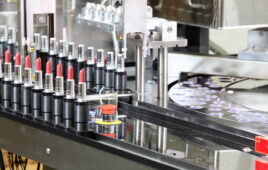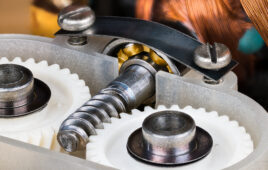Selecting a rotary encoder for a motion control system depends on a number of factors, chief of which are the accuracy requirements of the application, whether it’s position and/or velocity control. Before deciding which encoder to select, consider the most important factors which include:
- Positioning accuracy
- Speed stability
- Audible noise
- Power loss
- Bandwidth, which determines drive command-signal response
Positioning accuracy depends solely on the application requirements. Resolvers, for example, mostly have one signal period per revolution. Therefore, the position resolution is extremely limited and the accuracy typically is in the range of ±500” (arc seconds), assuming interpolation in the drive electronics usually results in a total of 16,384 positions per revolution.
On the other hand, an inductive scanning system, as found in many rotary encoders, will provide significantly higher resolution, typically in the range of 32 signal periods per revolution resulting in an accuracy of ±280”. The interpolation in this case is internal to the encoder resulting in 131,072 positions per revolution.
Optical rotary encoders are based on very fine graduations commonly with 2048 signal periods per revolution and therefore even much higher resolutions are possible with internal interpolation electronics. The output resolution here is 25-bits, 33,554,432 absolute positions per revolution with accuracies in the range of ±20”.
To ensure smooth drive performance, an encoder must provide a large number of measuring steps per revolution as the first piece of the puzzle. However, an engineer must also pay attention to the quality of the encoder signals. In order to get high resolution, the scanning signals must be interpolated. Inadequate scanning, contamination of the measuring standard, and insufficient signal conditioning can lead to the signals deviating from the ideal shape. During interpolation, errors can occur whose periodic cycle is within one signal period. Therefore, these position errors within one signal period are also referred to as “interpolation error”. With high quality encoders, these errors are typically 1 to 2% of the signal period.
The interpolation error adversely affects the positioning accuracy, and also significantly degrades the speed stability and audible noise behavior of the drive. The speed controller calculates the nominal currents used to brake or accelerate the drive depending on the error curve. At low feed rates, the feed drive lags the interpolation error. At increasing speeds, the frequency of the interpolation error also increases. Since the motor can only follow the error within the control bandwidth, its effect on the speed stability behavior decreases as the speed increases. However, the disturbances in the motor current continue to increase, which leads to noises in the drive at high control-loop gains.
Higher resolutions and accuracies also reduce disturbances in the motor current in the way of heat generation and power loss.
Bandwidth (relative to command response and control reliability) can be limited by the rigidity of the coupling between the motor shaft and encoder shaft as well as by the natural frequency of the coupling. Encoders are qualified to operate within a specified acceleration range. Values typically range from 55 to 2,000 Hz. However, if the application or poor mounting cause long lasting resonant vibration, it will limit performance and possibly damage the encoder.
Natural frequencies vary depending on the stator coupling design. This frequency needs to be as high as possible for optimal performance. The key is to ensure that the bearing of the encoder and the bearing of the motor are as close to perfect alignment as possible. The matching tapers of the motor shaft and encoder ensures near perfect alignment to the centerline.
This mechanical configuration will result in a holding torque approximately 4x greater than a standard hollow shaft encoder with a 2-mounting tab stator coupling. This will increase the bearing life of the encoder as well as provide exceptional natural frequency / acceleration properties. Additionally, this configuration will virtually eliminate any limits on the bandwidth of the drive.
Filed Under: Encoders (rotary) + resolvers, Motion Control Tips




